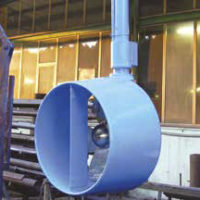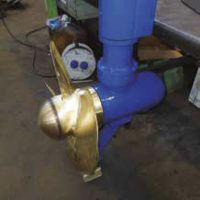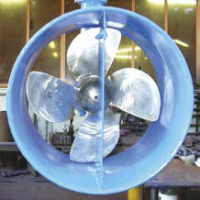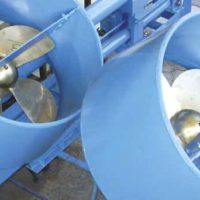Miotto outdrives are able to provide the best performance among the others available on the market with the same installed power. For applications from 20 to 300 KW with electrical or hydraulic motor. They are available with free or ducted propeller. They can, in operation, move vertically in addition to allowing turns, thanks to their rotation with up to 40° rudder angles.
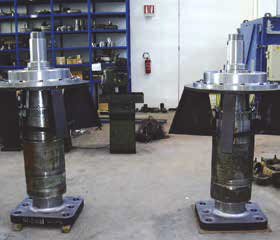 The PPM-type overdrive involves the coupling with an hydraulic motor, connected to the vertical transmission shaft through a bevel gearbox with high reduction ratio, which allows to use high-efficiency 4-blades propeller with low cavitation index. Very easy to mount, the overdrive has been designed to minimise the overall dimensions allowing a quick mounting on another vessel and easy maintenance. The feasibility to be coupled with hydraulic motor enables the design of other hydraulic circuits for on-board auxiliary services.
The PPM-type overdrive involves the coupling with an hydraulic motor, connected to the vertical transmission shaft through a bevel gearbox with high reduction ratio, which allows to use high-efficiency 4-blades propeller with low cavitation index. Very easy to mount, the overdrive has been designed to minimise the overall dimensions allowing a quick mounting on another vessel and easy maintenance. The feasibility to be coupled with hydraulic motor enables the design of other hydraulic circuits for on-board auxiliary services.
The feasibility to slide on strong sliding guides, thanks to an appropriate hydraulic cylinder, allows to the vessels which use this product a drivability not even comparable to similar vessels. Even in out-of-water propeller conditions the vessel can smoothly operate, for example in low-water areas or if there are some underwater obstacles (rocks, shoals, scarp, etc). During the navigation the overdrive can be completely immersed, ensuring the propeller to work in optimal condition (without “regression”).
Decades of experience in the manufacturing of propellers allowed Miotto Industrial and Marine Technologies Ltd to achieve optimal propulsive characteristics of its groups, which have no equals on other available applications having the same nominal power. The propeller could be provided made of alloy bronze or aluminium.
Moreover, operating with directional thruster allows to obtain a drivability and an operational readiness way greater than the traditional rudder-propeller system. Indeed, for the latter the low-speed operations are often very challenging even for the most experienced captains.
For vessels equipped with directional thruster the evolution radius and the stopping distance are, indeed, very limited.
